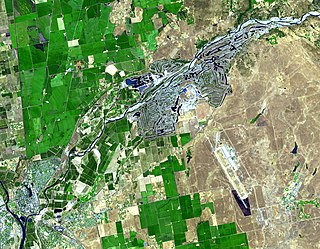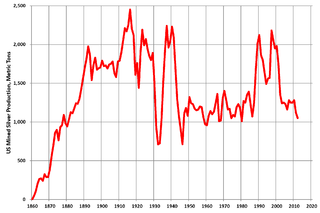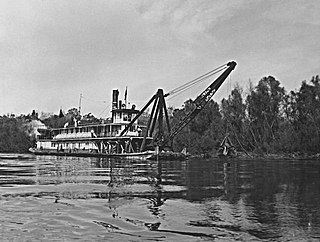
Prescott Valley is a town located in Yavapai County, Arizona, United States, approximately 8 miles (13 km) east of Prescott. According to the 2020 United States Census, Prescott Valley has a population of 46,785 residents.

Sumpter is a city in Baker County, Oregon, United States. The population was 204 at the 2010 census. Sumpter is named after Fort Sumter by its founders. The name was inspired by a rock as smooth and round as a cannonball, which reminded a local resident of the American Civil War and Fort Sumter.

Skidoo was an unincorporated community in Inyo County, California. The geographical location of the old town site lies at an elevation of 5,689 feet. Skidoo is a ghost town located in Death Valley National Park. It is on the National Register of Historic Places.
The Discovery Mine was a gold mine 84 kilometers northeast of Yellowknife, Northwest Territories that operated between 1950 and 1969. Gold was discovered here by Alfred Giauque in 1944. A complete townsite, on Giauque Lake, was established by the company to house workers and their families. The mine produced one million troy ounces (31,000 kg) of gold from one million tons of ore. The abandoned townsite, not accessible by road, was demolished in 2005.

The Sumpter Valley Railway, or Sumpter Valley Railroad, is a 3 ft narrow gauge heritage railroad located in Baker County, in the U.S. state of Oregon. Built on a right-of-way used by the original railway of the same name, it carries excursion trains on a roughly 5-mile (8.0 km) route between McEwen and Sumpter. The railroad has two steam locomotives and several other pieces of rolling stock. Passenger excursion trains operate on weekends and holidays from Memorial Day through the end of September.

The Yuba Goldfields, also known as the Hammonton dredge field, is the largest gold dredge field in California. Located along the Yuba River approximately 6–12 miles (10–20 km) upstream of the town of Marysville, in Yuba County, the Hammonton dredge field was actively dredged for gold from 1904 to 1968. In total, more than one billion cubic yards of river sediment and lesser hydraulic mining debris was dredged to produce an estimated 5.14 million ounces of gold. The goldfields are noted for their otherworldly appearance, filled with roughly linear mounds of gravels, ravines, streams and turquoise-colored pools of water. From the air, the goldfields are said to resemble intestines.

Canemah was an early settlement in the U.S. state of Oregon located near the Willamette River. Canemah was annexed to Oregon City in 1928.

Gold became highly concentrated in California, United States as the result of global forces operating over hundreds of millions of years. Volcanoes, tectonic plates and erosion all combined to concentrate billions of dollars' worth of gold in the mountains of California. During the California Gold Rush, gold-seekers known as "Forty-Niners" retrieved this gold, at first using simple techniques, and then developing more sophisticated techniques, which spread around the world.

Silver mining in the United States began on a major scale with the discovery of the Comstock Lode in Nevada in 1858. The industry suffered greatly from the demonetization of silver in 1873 by the Coinage Act of 1873, known pejoratively as the "Crime of 73", but silver mining continues today.

A gold dredge is a placer mining machine that extracts gold from sand, gravel, and dirt using water and mechanical methods.

Montgomery is a steam-powered sternwheel-propelled snagboat built in 1925 by the Charleston Dry Dock and Machine Company of Charleston, South Carolina, and operated by the United States Army Corps of Engineers. Montgomery cleared snags and obstructions from the Coosa, Alabama, Apalachicola, Chattahoochee, Flint, Black Warrior, and Tombigbee Rivers until her retirement from the Corps of Engineers on November 8, 1982. She was restored in 1984 and again in 2004. One of only two surviving Army Corps of Engineers snagboats, she was declared a National Historic Landmark in 1989. Montgomery now operates as a museum ship at the Tom Bevill Lock and Dam Visitor Center in Pickensville, Alabama.
Gold mining in Alaska, a state of the United States, has been a major industry and impetus for exploration and settlement since a few years after the United States acquired the territory in 1867 from the Russian Empire. Russian explorers discovered placer gold in the Kenai River in 1848, but no gold was produced. Gold mining started in 1870 from placers southeast of Juneau, Alaska.
Joe Bush is a legendary ghost that allegedly haunts the Sumpter Valley Gold Dredge in Sumpter, Oregon, United States. According to legend, dredge workers on the No. 42 dredge at Sumpter Valley claim the ghost leaves wet, bare footprints on the dredge's decks, causes lights to flicker, and doors to open and close unexpectedly. The ghost of Joe Bush also makes an appearance in the book series Skeleton Creek.

Sumpter Valley Railway Passenger Station was the westernmost station on the Sumpter Valley Railway, which ran 80 miles (130 km) from Baker City to Prairie City in the U.S. state of Oregon. The line reached Prairie City in 1910 but was abandoned in 1933, and the station became a private dwelling. Since 1984, the renovated station has housed the collections of the DeWitt Museum, including railway artifacts from the late 19th and early 20th centuries.

Davidson Ditch is a 90-mile (140 km) conduit built in the 1920s to supply water to gold mining dredges in central Alaska. It was the first large-scale pipeline construction project in Alaska, and lessons learned in its construction were applied to the building of the Trans-Alaska Pipeline System. It is eligible for inclusion on the National Register of Historic Places, but has not been listed due to a lack of information. Despite this, the remains of the conduit are partially protected by its inclusion in the White Mountains National Recreation Area.

Derry Mining Site Camp was a mining site camp near Leadville, Colorado that operated during 1916–1923. It is located on the old Twin Lakes Toll Road, at an elevation of 9,320 feet (2,840 m). The placer mine was established on and named after the Derry Ranch established by Samuel Derry, who purchased the land in May of 1878. He homesteaded and farmed hay that was sold to feed the animals that worked in the gold rush operations in Leadville. When Derry died in 1889, his son Calaincourt Derry inherited the ranch and continued farming it until his death in 1908, at which time the ranch was sold to the Saguache Gold Mining Company, which began small-scale placer mining.

The China Ditch in Douglas County, in the U.S. state of Oregon, was a 30-mile (48 km) canal built in part by Chinese laborers to supply water for the hydraulic mining of gold. The Myrtle Creek Consolidated Hydraulic Gold Mining and Manufacturing Company began purchasing land for the ditch in 1890 and was bankrupt by 1894. Portions of the ditch, which carried water from Little River to North Myrtle Creek, remain visible, and an 11-mile (18 km) section is listed on the National Register of Historic Places.

The Sumpter Valley Railway, Middle Fork Spur, near Bates, Oregon, was built in 1916. Also known as the Oregon Lumber Company Railroad, it was designed by engineer Joseph A. West. A linear historic district including 16.2 miles out of 23 original miles on the spur, from near Bates, Oregon, to the Mitchell Tract, historic end of the railroad, was listed on the National Register of Historic Places in 1987. The listing included three contributing structures: the roadbed, the Davis Creek Bridge, and a water tower at Big Boulder Creek.

Dredge No. 4 is a wooden-hulled bucketline sluice dredge that mined placer gold on the Yukon River from 1913 until 1959. It is now located along Bonanza Creek Road 13 kilometres (8.1 mi) south of the Klondike Highway near Dawson City, Yukon, where it is preserved as one of the National Historic Sites of Canada. It is the largest wooden-hulled dredge in North America.






















